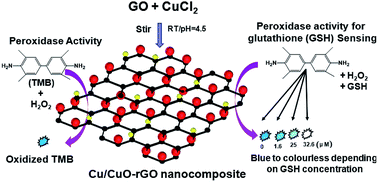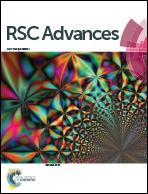Novel synthesis of a mixed Cu/CuO–reduced graphene oxide nanocomposite with enhanced peroxidase-like catalytic activity for easy detection of glutathione in solution and using a paper strip†
Abstract
A reduced graphene oxide (rGO) based mixed copper nanocomposite, Cu/CuO–rGO is prepared through a novel synthetic approach: a simple one-step oxidation–reduction reaction between aqueous graphene oxide (GO) and copper(II) chloride (CuCl2) solutions at ambient temperature and pressure. The nanocomposite shows enhanced peroxidase-like catalytic activity by rapidly catalyzing a TMB (3,3′,5,5′-tetramethyl benzidine)–H2O2 reaction that develops a visible blue color in solution due to the oxidation of TMB. The catalyst follows a Michaelis–Menten reaction mechanism and exhibits strong affinity towards both H2O2 and TMB. The blue color developed by the Cu/CuO–rGO–TMB–H2O2 system becomes colorless in solution when glutathione is present even at a very low concentration (0.032 μM). This distinct color change provides the basis of the present colorimetric method for highly sensitive and selective detection of GSH in solution as well as on a paper-strip within a <5 min time period. The use of Cu/CuO–rGO as an enzyme-like catalyst in TMB–H2O2 mediated GSH sensing process shows the benefits of simplicity, cost-effectiveness and provides an alternative non-enzymatic way of glutathione estimation in real samples such as commercially available tablets and human blood plasma.


 Please wait while we load your content...
Please wait while we load your content...